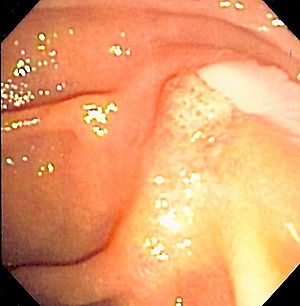Recurrent pyogenic cholangitis – Wikipedia
From Wikipedia, the free encyclopedia
Medical condition
| Recurrent pyogenic cholangitis | |
|---|---|
| Other names | Cholangiohepatitis, Hong Kong disease, Oriental chlangitis, Oriental cholangiohepatitis, biliary obstruction syndrome of the Chinese, Oriental cholangitis[1] |
 |
|
| Cholangitis | |
| Specialty | General surgery |
Recurrent pyogenic cholangitis (RPC), also known as Hong Kong disease, Oriental cholangitis, and Oriental infestational cholangitis, is a chronic infection characterized by recurrent bouts of bacterial cholangitis with primary hepatolithiasis.[1][2] It is exclusive to people who live or have lived in southeast Asia.[3][4][5]
Presentation[edit]
Presentation can be atypical and without pain or fever, especially in the elderly.[1] Positive symptoms include biliary colic, acute pancreatitis, obstructive jaundice and less commonly, liver enlargement and abnormal liver function tests.[1] Additional complications in the acute setting include ascending cholangitis, gallbladder empyema, clotting within the hepatic and portal veins, sepsis and death.[1]
Chronic biliary obstruction may cause jaundice, itchiness, liver abscesses, and cirrhosis, particularly at the left lobe segment 3, and can eventually lead to intraductal papillary mucinous neoplasm or cholangiocarcinoma.[6][7][8][9]
Pathogenesis[edit]
With RPC, the gallstones found within the biliary system are made of calcium bilirubinate or pigmented calcium. Calcium bilirubinate stones are prevalent in Asia and very rare in Europe and the United States. They tend to be friable concretions of various shapes and sizes within the biliary tree, and their associated bile is often muddy in consistency and contains numerous fine particles of calcium bilirubinate as well. This differs greatly from cholesterol stones, which are common in Europe and the United States. The formation of calcium bilirubinate stones in RPC has been attributed to a high incidence of infection with Escherichia coli in bile. In humans, the majority of bilirubin is excreted in the bile as bilirubin glucuronide.[citation needed]
Hepatolithiasis is associated with Clonorchis sinensis and Ascaris lumbricoides infestation of the liver. This theory is based on high incidence of dead parasites or ova within stone in autopsy findings.[10][11]
Diagnosis[edit]
The diagnosis can be suspected by imaging, with typical characteristics centering around appearance of the liver, typically with CT, ultrasound or MRI. Traits that raise suspicion for the infection include intra- and extra- hepatic dilatation and strictures with intraductal pigmented stones, usually in the absence of gallstones and with regions of segmental liver atrophy, particularly the lateral aspect of the left hepatic lobe. There is also reduced arborization of peripheral ducts. Approximately 5% of chronic infections go on to develop cholangiocarcinoma.[12]
Pathogenic bacteria responsible for the infection include E. coli, Klebsiella, Pseudomonas, and Proteus species. Anaerobes are a less frequent cause, and a culture positive for multiple strains can be common.[13][14] When related to Clonorchis sinensis, definitive diagnosis is by identification of eggs by microscopic demonstration in faeces or in duodenal aspirate, but other sophisticated methods have been developed, such as ELISA, which has become the most important clinical technique. Diagnosis by detecting DNAs from eggs in faeces are also developed using PCR, real-time PCR, and LAMP, which are highly sensitive and specific.[citation needed]
Treatment[edit]
The treatment of RPC involves management of sepsis during episodes of cholangitis with antibiotics, abscess drainage, and blood pressure support. With resistant infection, a surgical hepatectomy or hepaticocutaneousjejunostomy can be performed. Lifelong surveillance for malignancy is also usually necessary.[15]
See also[edit]
References[edit]
- ^ a b c d e Tsui, Wilson; Chan, Yiu-kay; Wong, Chi-tat; Lo, Yan-fai; Yeung, Yat-wah; Lee, Yat-wing (2011). “Hepatolithiasis and the Syndrome of Recurrent Pyogenic Cholangitis: Clinical, Radiologic, and Pathologic Features”. Seminars in Liver Disease. 31 (1): 033–048. doi:10.1055/s-0031-1272833. PMID 21344349.
- ^ Digby, Kenelm (1930). “Common‐duct stones of liver origin”. The British Journal of Surgery. 17 (68): 578. doi:10.1002/bjs.1800176804.
- ^ Miyake, H; Johnston, CG (1968). “Gallstones: ethnological studies”. Digestion. 1 (4): 219–28. doi:10.1159/000196857. PMID 5696243.
- ^ Nakayama, F; Soloway, RD; Nakama, T; Miyazaki, K; Ichimiya, H; Sheen, PC; Ker, CG; Ong, GB; Choi, TK; Boey, J (January 1986). “Hepatolithiasis in East Asia. Retrospective study”. Digestive Diseases and Sciences. 31 (1): 21–6. doi:10.1007/BF01347905. PMID 3940820.
- ^ ONG, GB (February 1962). “A study of recurrent pyogenic cholangitis”. Archives of Surgery. 84 (2): 199–225. doi:10.1001/archsurg.1962.01300200047004. PMID 14482034.
- ^ Caroli, J. (1973-01-01). “Diseases of the intrahepatic biliary tree”. Clinics in Gastroenterology. 2 (1): 147–161. ISSN 0300-5089. PMID 4594323.
- ^ Lim, J. H. (1991-07-01). “Oriental cholangiohepatitis: pathologic, clinical, and radiologic features”. AJR. American Journal of Roentgenology. 157 (1): 1–8. doi:10.2214/ajr.157.1.2048504. ISSN 0361-803X. PMID 2048504.
- ^ Fan, S. T.; Choi, T. K.; Lo, C. M.; Mok, F. P.; Lai, E. C.; Wong, J. (1991-04-01). “Treatment of hepatolithiasis: improvement of result by a systematic approach”. Surgery. 109 (4): 474–480. ISSN 0039-6060. PMID 2008653.
- ^ Lee, W. J.; Lim, H. K.; Jang, K. M.; Kim, S. H.; Lee, S. J.; Lim, J. H.; Choo, I. W. (2001-10-01). “Radiologic spectrum of cholangiocarcinoma: emphasis on unusual manifestations and differential diagnoses”. Radiographics. 21 Spec No: S97–S116. doi:10.1148/radiographics.21.suppl_1.g01oc12s97. ISSN 0271-5333. PMID 11598251.
- ^ Chou, S. T.; Chan, C. W. (1980-07-01). “Recurrent pyogenic cholangitis: a necropsy study”. Pathology. 12 (3): 415–428. doi:10.3109/00313028009077105. ISSN 0031-3025. PMID 7432820.
- ^ Caroli, J. (1973-01-01). “Diseases of the intrahepatic biliary tree”. Clinics in Gastroenterology. 2 (1): 147–161. ISSN 0300-5089. PMID 4594323.
- ^ Park, MS; Yu, JS; Kim, KW; Kim, MJ; Chung, JP; Yoon, SW; Chung, JJ; Lee, JT; Yoo, HS (September 2001). “Recurrent pyogenic cholangitis: comparison between MR cholangiography and direct cholangiography”. Radiology. 220 (3): 677–82. doi:10.1148/radiol.2202001252. PMID 11526266.
- ^ Seel, DJ; Park, YK (September 1983). “Oriental infestational cholangitis”. American Journal of Surgery. 146 (3): 366–70. doi:10.1016/0002-9610(83)90417-8. PMID 6614329.
- ^ Carmona, RH; Crass, RA; Lim RC, Jr; Trunkey, DD (July 1984). “Oriental cholangitis”. American Journal of Surgery. 148 (1): 117–24. doi:10.1016/0002-9610(84)90298-8. PMID 6377937.
- ^ Co, M; Pang, SY; Wong, KY; Ip, WK; Yuen, WK (August 2014). “Surgical management of recurrent pyogenic cholangitis: 10 years of experience in a tertiary referral centre in Hong Kong”. HPB. 16 (8): 776–80. doi:10.1111/hpb.12185. PMC 4113261. PMID 24246050.
External links[edit]
Recent Comments